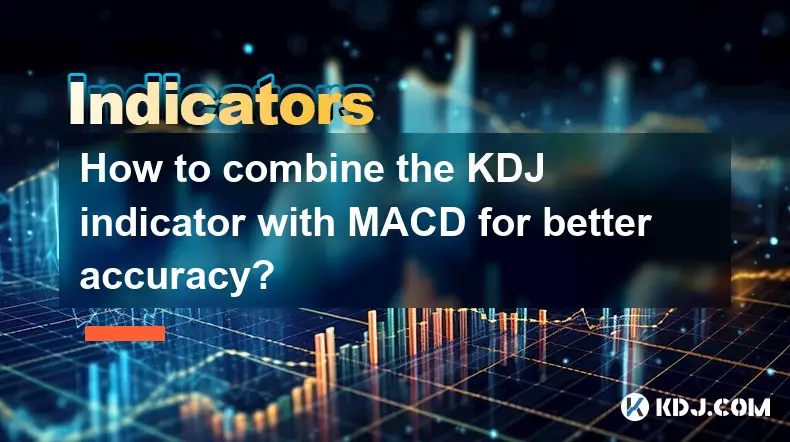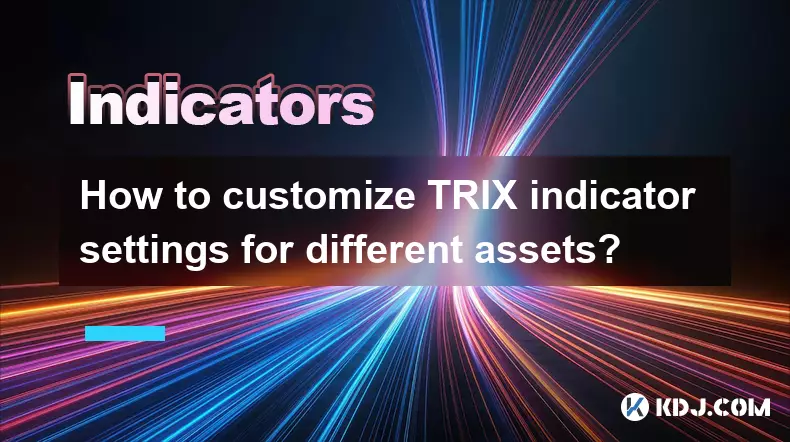-
 bitcoin
bitcoin $100977.009184 USD
-2.05% -
 ethereum
ethereum $3282.009150 USD
-3.23% -
 tether
tether $0.999813 USD
-0.02% -
 xrp
xrp $2.208254 USD
-4.89% -
 bnb
bnb $951.411089 USD
0.55% -
 solana
solana $155.761205 USD
-2.84% -
 usd-coin
usd-coin $1.000217 USD
0.02% -
 tron
tron $0.284475 USD
-1.28% -
 dogecoin
dogecoin $0.162363 USD
-1.53% -
 cardano
cardano $0.533988 USD
-0.47% -
 hyperliquid
hyperliquid $39.174339 USD
-3.22% -
 chainlink
chainlink $14.724828 USD
-1.16% -
 bitcoin-cash
bitcoin-cash $477.297986 USD
-1.28% -
 zcash
zcash $554.227426 USD
17.30% -
 ethena-usde
ethena-usde $0.998995 USD
-0.03%
How to combine the KDJ indicator with MACD for better accuracy?
The KDJ and MACD indicators complement each other in crypto trading, with KDJ spotting overbought/oversold levels and MACD confirming momentum, improving signal accuracy.
Nov 06, 2025 at 10:40 am

Understanding the KDJ Indicator in Cryptocurrency Trading
1. The KDJ indicator, originating from stochastic oscillator principles, is widely used in cryptocurrency markets to identify overbought and oversold conditions. It consists of three lines: %K (fast line), %D (slow line), and %J (divergence line). These lines help traders assess momentum and potential reversal points within volatile digital asset price movements.
2. In fast-moving crypto markets, the sensitivity of the KDJ makes it particularly useful for detecting short-term turning points. When the %K line crosses above the %D line in the oversold zone (typically below 20), it may signal a bullish reversal. Conversely, when %K crosses below %D in the overbought region (above 80), it could indicate a bearish shift.
3. Traders often adjust the smoothing periods of the KDJ to better suit the high-frequency nature of cryptocurrencies. A common configuration uses 9-period settings with 3-period smoothing for %D, allowing quicker responses to sudden price swings seen in assets like Bitcoin or Ethereum.
4. One limitation of relying solely on KDJ is the occurrence of false signals during strong trending phases. During extended bull or bear runs, the indicator may remain in overbought or oversold territory for prolonged periods, leading to premature entries if not confirmed by other tools.
Role of MACD in Confirming Market Momentum
1. The Moving Average Convergence Divergence (MACD) measures the relationship between two exponential moving averages (EMAs) and a signal line, offering insights into trend strength and direction. In crypto trading, MACD helps distinguish between genuine trends and temporary price noise.
2. A key feature of MACD is the histogram, which visualizes the distance between the MACD line and the signal line. Expanding green bars suggest increasing bullish momentum, while growing red bars indicate strengthening downward pressure—both critical cues in fast-paced digital currency markets.
3. Crossovers between the MACD line and its signal line are commonly interpreted as trade signals. A bullish crossover occurs when the MACD line rises above the signal line, especially when emerging from negative territory. This often aligns with the start of upward price acceleration in cryptocurrencies.
4. Divergences between MACD and price action can precede major reversals. For instance, if Bitcoin reaches a new high but MACD fails to surpass its previous peak, this bearish divergence might warn of weakening momentum before a correction unfolds.
Combining KDJ and MACD for Enhanced Signal Accuracy
1. Traders increase reliability by waiting for both KDJ and MACD to generate congruent signals before entering a position. For example, a long entry may be considered only when KDJ exits the oversold zone with %K crossing above %D, while simultaneously MACD generates a bullish crossover above the zero line.
2. During consolidation phases, KDJ can provide early warnings of breakout attempts, while MACD confirms whether the breakout has sufficient momentum. If KDJ moves sharply from oversold levels and MACD histogram begins expanding positively, it strengthens the case for a valid upward move.
3. In strong downtrends, using KDJ alone might lead to catching falling knives. However, combining it with MACD ensures that any attempted bounce is not just a retracement. Only when MACD shows signs of flattening or turning up from deep negative values should KDJ-generated buy signals be taken seriously.
4. Timeframe alignment enhances accuracy. Applying both indicators on multiple timeframes—such as confirming a 4-hour KDJ crossover with daily MACD trend direction—reduces whipsaw trades and improves decision-making in volatile crypto environments.
Frequently Asked Questions
What does a bullish divergence look like on KDJ and MACD?A bullish divergence appears when the price makes lower lows, but the KDJ forms higher lows, indicating reduced selling pressure. Simultaneously, MACD shows a higher low in its line or histogram, suggesting momentum is shifting upward despite continued price decline.
Can KDJ and MACD be used effectively in sideways crypto markets?Yes, in ranging markets, KDJ excels at identifying overbought and oversold levels near resistance and support zones. MACD typically remains flat around the zero line. Together, they help traders fade the extremes—selling near resistance when KDJ hits overbought and MACD shows no strong momentum, buying near support under opposite conditions.
How do you adjust KDJ and MACD settings for different cryptocurrencies?Highly volatile coins like meme tokens may require faster KDJ settings (e.g., 5,3,3) to capture rapid swings, while larger-cap assets like BTC or ETH perform better with standard 9,3,3. For MACD, reducing EMA periods (e.g., 8,17,9 instead of 12,26,9) can make it more responsive to quick price changes in altcoins.
Disclaimer:info@kdj.com
The information provided is not trading advice. kdj.com does not assume any responsibility for any investments made based on the information provided in this article. Cryptocurrencies are highly volatile and it is highly recommended that you invest with caution after thorough research!
If you believe that the content used on this website infringes your copyright, please contact us immediately (info@kdj.com) and we will delete it promptly.
- BlockDAG, Avalanche, Dogecoin: Crypto's Leading Trio in 2025
- 2025-11-07 22:05:01
- Layer 2 Coins: Will There Be a Potential Explosion by 2026?
- 2025-11-07 16:50:02
- Filecoin, ICP, and the AI Infrastructure Renaissance: Is History Repeating?
- 2025-11-07 16:50:02
- Bitcoin's Wild Ride: Surges, Zeros, and the Search for Stability
- 2025-11-07 17:05:01
- XRP, Bitcoin, and the Rally: What's the Deal, New York?
- 2025-11-07 17:25:01
- Filecoin, DePIN, and a Technical Breakout: What's the Buzz?
- 2025-11-07 17:05:01
Related knowledge

How do professional traders use the TRIX indicator?
Nov 06,2025 at 04:40pm
Understanding the TRIX Indicator in Crypto TradingThe TRIX (Triple Exponential Average) indicator is a momentum oscillator used by professional trader...

Can I use the TRIX indicator on my mobile trading app?
Nov 07,2025 at 07:40pm
The TRIX indicator, a momentum oscillator designed to filter out short-term fluctuations and highlight long-term trends, has become increasingly popul...

How to code a simple TRIX indicator script in Pine Script?
Nov 07,2025 at 06:20am
How to Code a Simple TRIX Indicator in Pine Script The TRIX (Triple Exponential Moving Average) indicator is widely used in cryptocurrency trading to ...

How to trade TRIX indicator signals on the 1-hour chart?
Nov 07,2025 at 05:39am
Bitcoin's Role in Decentralized Finance1. Bitcoin remains the cornerstone of decentralized finance, serving as a benchmark for value and security acro...

Can the TRIX indicator be used for long-term investing?
Nov 06,2025 at 02:19pm
Understanding the TRIX Indicator in Cryptocurrency Markets1. The TRIX (Triple Exponential Average) indicator is a momentum oscillator designed to filt...

How to customize TRIX indicator settings for different assets?
Nov 06,2025 at 03:39pm
Understanding the TRIX Indicator in Cryptocurrency Trading1. The TRIX (Triple Exponential Average) indicator is a momentum oscillator designed to filt...

How do professional traders use the TRIX indicator?
Nov 06,2025 at 04:40pm
Understanding the TRIX Indicator in Crypto TradingThe TRIX (Triple Exponential Average) indicator is a momentum oscillator used by professional trader...

Can I use the TRIX indicator on my mobile trading app?
Nov 07,2025 at 07:40pm
The TRIX indicator, a momentum oscillator designed to filter out short-term fluctuations and highlight long-term trends, has become increasingly popul...

How to code a simple TRIX indicator script in Pine Script?
Nov 07,2025 at 06:20am
How to Code a Simple TRIX Indicator in Pine Script The TRIX (Triple Exponential Moving Average) indicator is widely used in cryptocurrency trading to ...

How to trade TRIX indicator signals on the 1-hour chart?
Nov 07,2025 at 05:39am
Bitcoin's Role in Decentralized Finance1. Bitcoin remains the cornerstone of decentralized finance, serving as a benchmark for value and security acro...

Can the TRIX indicator be used for long-term investing?
Nov 06,2025 at 02:19pm
Understanding the TRIX Indicator in Cryptocurrency Markets1. The TRIX (Triple Exponential Average) indicator is a momentum oscillator designed to filt...

How to customize TRIX indicator settings for different assets?
Nov 06,2025 at 03:39pm
Understanding the TRIX Indicator in Cryptocurrency Trading1. The TRIX (Triple Exponential Average) indicator is a momentum oscillator designed to filt...
See all articles





















![The Graph Price Prediction [GRT Crypto Price News Today] The Graph Price Prediction [GRT Crypto Price News Today]](/uploads/2025/11/07/cryptocurrencies-news/videos/690d4df44fe69_image_500_375.webp)




















































